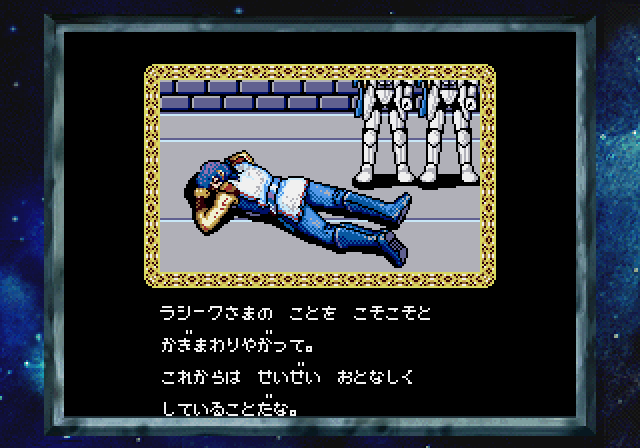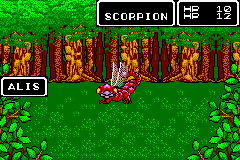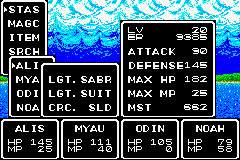Retro Replay Review
Gameplay
Phantasy Star Collection brings together three of Sega’s pioneering sci-fi RPGs—Phantasy Star, Phantasy Star II, and Phantasy Star III: Generations of Doom—with the Saturn edition rounding out the set by adding Phantasy Star IV: The End of the Millennium. Each title preserves its original turn-based battle system, complete with random encounters, party management, and menu-driven commands. While the core loop remains faithful to the 8- and 16-bit eras, an array of modern conveniences—such as save-state support, fast-forward toggles, and on-screen world maps—helps new players navigate these sprawling worlds without the frustration of hunting for a physical strategy guide.
(HEY YOU!! We hope you enjoy! We try not to run ads. So basically, this is a very expensive hobby running this site. Please consider joining us for updates, forums, and more. Network w/ us to make some cash or friends while retro gaming, and you can win some free retro games for posting. Okay, carry on 👍)
The engage-and-retreat rhythm of battles is as strategic as ever. You’ll weigh elemental weaknesses, equip a variety of weapons and armor, and juggle limited MP reserves even in the earliest chapters. Later titles introduce quality-of-life improvements—shorter encounter animations, rebalanced experience curves, and built-in party AI presets—so you can spend more time exploring and less time grinding. Serious series veterans will appreciate tracking down hidden spells, branching dialogue instances, and bonus dungeons, all unobstructed by antiquated save formats or obscure password systems.
Exploration feels both nostalgic and fresh. The first Phantasy Star’s blocky dungeons recall the dawn of graphical RPGs, while eye-level 2D views in Phantasy Star II and III show the series in its 16-bit prime. Clever dungeon puzzles, NPC side-quests, and the occasional ship-to-ship skirmish in PSII add variety to the standard “walk, talk, fight” template. When you finally reach the climactic boss battles in each installment, the challenge remains suitably old-school but never unfair, thanks to the ability to tweak encounter rates or rewind to safety on a whim.
Graphics
Visually, the collection is a lesson in evolution. Original pixel art is displayed in its native aspect ratio, retaining the sharp, low-resolution sprites of the Master System and Genesis eras. If square pixels aren’t your style, optional filters offer smoothing, scanlines, or a CRT-style glow to mimic an old tube television. Whether you prefer raw retro authenticity or a polished “arcade cabinet” look, the presentation caters to both camps.
Phantasy Star II and III shine brightest, with richer color palettes and more detailed character portraits that hint at the leap from 8-bit to 16-bit hardware. The Saturn-exclusive inclusion of Phantasy Star IV boosts the set with beautifully drawn anime-inspired cutscenes and hand-painted backgrounds, showcasing pre-rendered effects that were revolutionary for their time. Even in motion, sprite animations—like the heroine’s sword slash or a mech’s laser spin—retain a satisfying fluidity that still reads well on modern displays.
Beyond mere emulation, the collection’s UI enhancements prove invaluable. Menus pop up crisply, text boxes can be resized or recolored for readability, and you can toggle character portrait visibility during dialogue. The consistent frame rate and near-instant loading reduce the hardware quirks that once defined the originals. These graphical niceties ensure that immersion isn’t broken by technical hiccups, letting you focus on the story and exploration.
Story
The narrative arc spans star systems and generations, weaving a tapestry that’s surprisingly cohesive even as you jump from one entry to the next. Phantasy Star introduces Alis Landale’s quest for justice on the ice-shrouded world of Palma, establishing themes of rebellion and ancient prophecy. Its sequel leaps a thousand years forward, presenting a darker, more political drama in Phantasy Star II, where colony politics and rogue technologies threaten entire worlds.
Phantasy Star III: Generations of Doom takes a bold detour, chronicling three generations of a family dynasty as politics, romance, and hidden machinations drive the plot. While its branching paths and multiple protagonists can feel episodic, they reward repeat playthroughs with new alliances and endings. Finally, the Saturn-exclusive Phantasy Star IV delivers a climactic finish: layered mysteries, time travel, and a cast of beloved characters converge in an epic showdown that ties nearly two decades of lore together.
Despite some dated dialogue and occasional localization quirks, the overarching storyline remains one of the most ambitious in classic JRPGs. Character development deepens with each installment—from Alis’s righteous fury to the stoic heroism of Chaz in PSIV—offering emotional payoffs that still land. Music themes, such as the wistful “Challenge From the Future” or the stirring “Tower of the Dark”), bolster key moments, making memorable finales that longtime fans still hum today.
Overall Experience
Phantasy Star Collection is a remarkable value proposition for retro RPG enthusiasts and curious newcomers alike. By packaging three foundational titles (and a fourth on Saturn) into one cohesive set, it chronicles the technical and narrative growth of one of Sega’s signature series. Modern emulation features—save states, rewind, display options—mean you can tailor the experience to your patience threshold, making hours of classic gameplay accessible rather than arduous.
The collection’s structure encourages a marathon playthrough across all four games, yet each chapter stands alone as a distinct adventure. Whether you’re drawn to the minimalist challenge of the original Phantasy Star or the grand finale’s anime-style dramatics, there’s something here to satisfy both completionists and casual explorers. The seamless menu interfaces, combined with music and sound effects that remain largely intact, foster an immersive retro atmosphere without the guesswork of digging up old hardware or cartridges.
In the end, Phantasy Star Collection is more than a mere nostalgia trip—it’s a living anthology that highlights the enduring appeal of turn-based RPG design. While some mechanics may feel antiquated next to modern epics, the robust storytelling, inventive world-building, and sense of discovery maintain their charm. For anyone seeking a comprehensive look at the birth and maturation of a genre, this compilation remains an essential purchase.
 Retro Replay Retro Replay gaming reviews, news, emulation, geek stuff and more!
Retro Replay Retro Replay gaming reviews, news, emulation, geek stuff and more!









Reviews
There are no reviews yet.